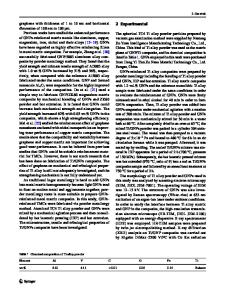Study of tribological properties of lubricating oil blend added with graphene nanoplatelets
- PDF / 694,976 Bytes
- 7 Pages / 584.957 x 782.986 pts Page_size
- 80 Downloads / 233 Views
is paper investigates the effects of graphene nanoplatelets (GNPs) as additives in palm-oil trimethylolpropane (TMP) ester blended in polyalphaolefin. Different concentrations of GNPs that were ultrasonically homogenized in blended lubricants consist of 95 vol% polyalphaolefin and 5 vol% TMP ester. Physical properties of the nanolubricants were identified and tribological behaviors of GNP in blended lubricants were studied using standard fourball testing and surface analysis was done on the wear surfaces using scanning electron microscopy and energy-dispersive x-ray techniques. Addition of 0.05 wt% GNP in blended lubricant resulted in the lowest coefficient of friction and wear scar diameter, thus selected as the most suitable concentration of GNP in the blended lubricant. Friction and wear were reduced by 5 and 15% respectively, with the presence of 0.05 wt% GNP in the blended lubricant.
I. INTRODUCTION
Lubricants are widely used in applications such as machining industries, automotive and others. The main characteristics of lubricants are its lubricity, the ability of lubricant to reduce friction that exists between surfaces when they are in relative motion.1 Due to continuous environmental legislations and increasing customer awareness, lubricant industry is striving for lubrication solutions which should be biodegradable and environmentally friendly. Conventional lubricants are mixtures of hydrocarbons blended with additives for specific lubrication requirements. These mixtures consist of paraffins, isoparaffines, nephthalenes, aromates, and compounds of sulfur, phosphors, nitrogen, and oxygen.2 Additives present in conventional engine oils contain sulfur and phosphorous based compounds, which are harmful to the environment.3,4 The amount of unburned lubricant has been proved to be a predominant contributor to undesirable paraffins and hydrocarbon emissions.5 The use of conventional engine lubricants results in toxic exhaust emissions and harmful particulate matters. In addition to environmental hazards, the health risks include eye irritation, allergic contact dermatitis and mutagenicity.6,7 At present, several regulations are implemented globally which limit the Sulfated Ash, Phosphorous and Sulfur (SAPS) contents of additives.7 Therefore, an environmentally friendly solution is required without Contributing Editor: Mohd Fadzli Bin Abdollah a) Address all correspondence to this author. e-mail: [email protected] DOI: 10.1557/jmr.2016.24 J. Mater. Res., 2016
http://journals.cambridge.org
Downloaded: 06 May 2016
compromising the lubrication performance of conventional lubricants. In this regard, a number of studies have presented biolubricants as an alternative solution but their wear protection and lubrication performance have remained questionable. Due to their low wear protection and low thermal and oxidation stability, such biobased oils have been used in blends with conventional oils.8 Masjuki et al. discovered the usage of Palm Oil Methyl Esters as lubricating engine oil additives in a two-stroke engine. Thus,
Data Loading...











